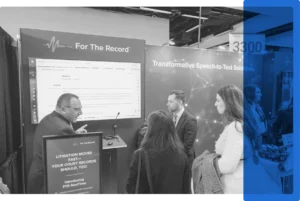
29 Mar
2023
2023 Court Technology Trends: How Data and Access are Key Drivers for Courtroom Modernization
Each year, we predict the technology trends we think will be most prominent in the justice space. Reflecting on 2022, we witnessed these trends manifest and evolve in various ways across the U.S. during the year—and we continue to see their impact three months into 2023.
People-centric justice administration
Over the course of the year, we witnessed an increase in the focus on people-centric justice administration, as courts seek to learn about and address the specific needs of individuals—be it economic factors, digital and general literacy, disability access, language access, attorney access, or self-representation access.
People-centric justice services are available in a range of accessible formats, are responsive to the individual’s situation, encourage meaningful participation in proceedings, offer clear communication about key details, and provide points of contact for clarification or support.
Addressing the digital divide
The ongoing digitization of court processes has unfortunately exacerbated the negative impacts of the digital divide on people from different parts of society. However, courts across the country have been working to address these impacts through a variety of solutions.
Ranging from partnering with local libraries to facilitate computer access, to providing technological support for court participants with minimal digital literacy, courts are working to ensure participants can successfully navigate the varied tasks involved in digital and remote court operations and proceedings.
Further leveraging of cloud technology
As more and more courts leverage cloud technology and establish ubiquitous—yet secure—access to court information (court records, evidence, case filings, calendars, etc.), continuity of court operations becomes the norm in the face of weather events or other large-scale disruptions. Access to court data is more easily granted, monitored, and revoked depending on the situation.
Digital court recording helps address stenographic court reporter supply gap
A new development in the complex issue facing the U.S. justice system—that of the stenographer shortage—emerged at the end of 2022. Californian court officials labelled the shortage “a crisis” when they released a joint statement calling for a review of their state’s statutory framework for court reporting, suggesting the framework “inhibits creative responses.”
Last year, we suggested the issue can be resolved without descending into a jobs-versus-technology argument, noting a human touch is still required to amplify the success of digital recording methods. As the need for a certified transcript for all situations is re-evaluated, focusing resources on capturing the proceedings exactly as they transpired ensures people can revisit the exact portion of a proceeding through the audio/video recording to resolve an issue.
This also provides the option for the proceeding to be transcribed at a later date if required, even if the court reporter wasn’t present during the session. The transcript can then be checked against the audio recording to ensure it is accurate—a process that can’t be replicated if stenography is utilized.
Looking ahead in 2023
This year, we are still seeing the impacts of these 2022 trends, with many courts continuing efforts to address the digital divide, ensure the uptake of new technology is people-centric, and work on solutions for the shortage of stenographers facing courts across the country.
In February 2023, the San Francisco Public Press reported on the progress for the implementation of digital recording in Californian courts more widely to address the stenographer shortage. They reported, “State Sen. Susan Rubio is planning to introduce a bill that would allow California’s 58 trial courts to digitally record civil and family law cases, a controversial effort to address statewide courtroom staffing shortages that deprive low-income litigants of official court transcripts.” Despite the significant opposition from stenographers, who have labelled digital methods as contentious, many courts across the country are operating digital court recording equipment successfully.
As court technology continues to evolve, other trends are also emerging in response to a variety of factors. Three months into 2023, we are witnessing three technology trends that are already impacting courts—and will continue to do so throughout the year.
Cybersecurity and data privacy
Both courts and justice technology providers alike will be investing in their cybersecurity protocols, ensuring data privacy and threat prevention are front of mind when implementing and managing court processes.
Though the increase in cybercrime and data breaches transcends industries, some courts may think they are not likely to be targets of these malicious activities as they don’t typically store large databases of credit card information. However, hackers can profit from stolen data in several ways, ranging from selling the data to other criminals and using login credentials to break into other accounts, to using the personal information for identity theft or for phishing attacks.
Without budgetary increases dedicated to boosting data security, courts are getting more creative with funding. Achieving multiple, interconnected goals of updating storage capabilities, while also boosting data security through updating legacy systems and processes, is a key driver for cloud migration in courts.
Refinement of hybrid hearing technology and processes
Since the onset of the pandemic, video conferencing technology is now a commonly used tool for remote court hearings, allowing for greater flexibility of and accessibility to court proceedings. This technology enables parties to participate in court proceedings remotely, which can be particularly useful for those who are unable to attend in person due to a variety of reasons. These reasons include the health and safety of the participant (e.g., in domestic and family violence cases), pre-existing commitments such as work or childcare arrangements, and an inability to commute from a remote or rural area.
However, given the speed at which courts were required to adapt to stay open when the pandemic hit, the adoption of remote technology has room for improvement and refinement.
Fit-for-purpose tools built specifically for justice settings is the way forward. Remote conferencing technology that can not only handle fully remote proceedings, but also hybrid hearings where people are participating from both the courtroom and from other places is crucial to effectively manage the modern justice system.
Automated speech-to-text draft transcripts increase accessibility during proceedings
The use of speech-to-text technology in the courtroom is set to revolutionize the accessibility of court proceedings and form part of the solution to the shortage of stenographers facing states across the country.
Provided optimum conditions through the adoption of best practices, speech-to-text platforms will reduce barriers to courtroom access; unlock immediate insights in a searchable court record; assist with labor shortages; bridge the gap between audio recordings of proceedings and certified transcripts; provide the foundation for certified transcripts; enhance operational efficiencies; offer court participants an additional accommodation option—and so much more.
Key takeaways
Technology is not here to replace lawyers, judiciary, or court reporters. Instead, these innovations equip the people who drive the justice system forward with the tools they require to boost efficiencies and make justice more accessible. However, without embedding this technology into carefully considered and comprehensive processes, courts won’t be setting themselves up for success.



